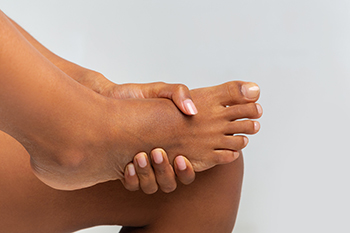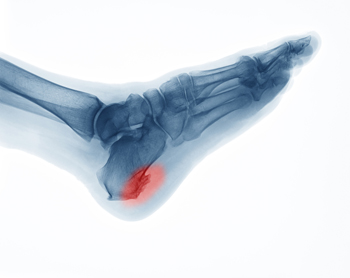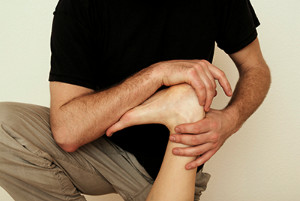Connect With Us
Blog
Items filtered by date: August 2022
Understanding Navicular Stress Fractures

The navicular bone is one of the 26 bones in the foot and is located across the inside top of the foot just in front of the ankle joint. The navicular connects the ankle to the foot bones and helps to form the arch that enables you to walk. Navicular stress fractures, which are hairline cracks in the bone, are often sustained by athletes who kick, twist or sprint. The result is often a chronic midfoot ache, but the vague location of the pain may make it difficult to diagnose. Hopping or standing on tiptoe can be one way of recognizing a navicular stress fracture. Someone with extremely high arches or a longer second toe may be more likely to sustain this injury, experts believe. X-rays may not be able to recognize navicular stress fractures, but an MRI or other imaging test can be more successful. Treatment may involve staying off the foot and wearing a cast for up to six weeks, or longer. If midfoot pain is becoming a nuisance, please consult with a podiatrist for a complete exam, diagnosis and options for treatment.
Stress fractures occur when there is a tiny crack within a bone. To learn more, contact David Mansky, DPM from Mansky Podiatry. Our doctor can provide the care you need to keep you pain free and on your feet.
How Are They Caused?
Stress fractures are the result of repetitive force being placed on the bone. Since the lower leg and feet often carry most of the body’s weight, stress fractures are likely to occur in these areas. If you rush into a new exercise, you are more likely to develop a stress fracture since you are starting too much, too soon. Pain resulting from stress fractures may go unnoticed at first, however it may start to worsen over time.
Risk Factors
- Gender – They are more commonly found in women compared to men.
- Foot Problems – People with unusual arches in their feet are more likely to develop stress fractures.
- Certain Sports – Dancers, gymnasts, tennis players, runners, and basketball players are more likely to develop stress fractures.
- Lack of Nutrients – A lack of vitamin D and calcium may weaken the bones and make you more prone to stress fractures
- Weak Bones – Osteoporosis can weaken the bones therefore resulting in stress fractures
Stress fractures do not always heal properly, so it is important that you seek help from a podiatrist if you suspect you may have one. Ignoring your stress fracture may cause it to worsen, and you may develop chronic pain as well as additional fractures.
If you have any questions, please feel free to contact our office located in Hastings, MI . We offer the newest diagnostic and treatment technologies for all your foot care needs.
Iselin Disease

Iselin disease is an overuse injury resulting from repetitive pressure or tension on the growth center at the base of the 5th metatarsal. Running and jumping can put a great amount of pressure on the forefoot. This disease affects children and usually resolves itself once the growth plate fuses, which generally occurs around age 12 for girls and 14 for boys. It cannot occur in adults because the growth plate closes over and turns into the bone with skeletal maturity at approximately 16 years of age. If your child has foot pain and you think it might be Iselin disease, consult with a podiatrist for proper management of discomfort associated with this condition. A pediatric immobilization brace may be used to offload the growth plate and allow for healing so that your child may maintain their activity level.
Some foot conditions may require additional professional care. If you have any concerns, contact David Mansky, DPM of Mansky Podiatry. Our doctor can provide the care you need to keep you pain-free and on your feet.
Rare Foot Conditions
The majority of foot conditions are common and can be treated by a podiatrist. Standard diagnostic procedures are generally used to identify specific conditions and treatment can be rendered. A podiatrist also treats rare foot conditions which can be difficult to diagnose and may need extra attention and care.
There are many rare foot conditions that can affect children. Some of these can include:
- Freiberg’s disease
- Kohler’s disease
- Maffucci syndrome
Freiberg’s disease - This can be seen as a deterioration and flattening of a metatarsal bone that exists in the ball of the foot. It typically affects pre-teen and teenage girls, but can affect anyone at any age. Symptoms that can accompany this can be swelling, stiffness, and the patient may limp.
Kohler’s disease - This often targets the bone in the arch of the foot and affects younger boys. It can lead to an interruption of the blood supply which ultimately can lead to bone deterioration. The patient may limp or experience tenderness, swelling, and redness.
Maffucci syndrome - This affects the long bones in a child’s foot leading to the development of abnormal bone lesions. They are benign growths and typically develop in early childhood and the bones may be susceptible to breaking.
A podiatrist can properly diagnose and treat all types of rare foot conditions. If your child is affected by any of these symptoms or conditions, please don’t hesitate to call our office so the correct treatment method can begin.
If you have any questions please feel free to contact our office located in Hastings, MI . We offer the newest diagnostic tools and technology to treat your foot and ankle needs.
Keep Your Feet Healthy So You Can Stay Active
What Is a Heel Spur?

A heel spur is a growth of bone that forms from extra calcium deposits on the foot and that stretch from the heel bone to the foot arch. It is one of the most common causes of heel pain. Heel spurs are a quarter of an inch in length or smaller, though they may become larger in some cases. They cannot be seen from outside of the body but can become quite painful, especially when jumping, running, or walking. There may be swelling of the heel and ankle with heel spurs. Some of the primary causes of heel spurs are ill fitting or non-supportive footwear, wearing high heels, bruising under the heel bone, poor posture or other physical structural issues (such as flat feet or high arches), or being overweight or obese. Other possible causes are having a pre-existing medical condition, like diabetes or arthritis, over-training, repetitive hard impact or pressure on the heel, and aging with calcium leaving the bones and settling into the bloodstream and attaching to the surface of bones. Women are more prone to developing heel spurs than men because their hips are naturally wider in comparison to their knees which causes additional pressure to be placed on the heel with movement. Routine foot care and exercises to reduce ligament stress and relieve bone tension will help invigorate heel tissues, but sometimes surgery will be required to remove a heel spur. If you have a heel spur and it is causing pain and interfering with your functioning, consult with a podiatrist who can recommend the best course of treatment.
Heel spurs can be incredibly painful and sometimes may make you unable to participate in physical activities. To get medical care for your heel spurs, contact David Mansky, DPM from Mansky Podiatry. Our doctor will do everything possible to treat your condition.
Heels Spurs
Heel spurs are formed by calcium deposits on the back of the foot where the heel is. This can also be caused by small fragments of bone breaking off one section of the foot, attaching onto the back of the foot. Heel spurs can also be bone growth on the back of the foot and may grow in the direction of the arch of the foot.
Older individuals usually suffer from heel spurs and pain sometimes intensifies with age. One of the main condition's spurs are related to is plantar fasciitis.
Pain
The pain associated with spurs is often because of weight placed on the feet. When someone is walking, their entire weight is concentrated on the feet. Bone spurs then have the tendency to affect other bones and tissues around the foot. As the pain continues, the feet will become tender and sensitive over time.
Treatments
There are many ways to treat heel spurs. If one is suffering from heel spurs in conjunction with pain, there are several methods for healing. Medication, surgery, and herbal care are some options.
If you have any questions feel free to contact our office located in Hastings, MI . We offer the latest in diagnostic and treatment technology to meet your needs.
Fascinating Feet

The foot is a fascinating and complicated structure. The entire body is supported by the feet, which consist of 26 bones and numerous tendons, ligaments, and muscles. There are three parts to the foot: the rear, mid, and forefoot. The arch of the foot is instrumental in absorbing the impact that comes from walking and running and acts as a lever that can move the foot. While standing normally, the body is balanced over the center of the foot and this places the greatest amount of stress on the arch. This pressure moves to the heel, which can hold approximately 50% of body weight. Many things naturally happen when walking occurs. The arch and surrounding tissues must absorb the impact as the heel strikes the ground and eventually pushes off as the step is completed. This is typically a smooth and coordinated movement, and any glitches during this process may result in foot pain. Additional stress is put on the ankles and arches with heavy patients, as the entire body works harder while walking. If you would like to know more information about foot structure, please consult with a podiatrist.
If you have any concerns about your feet, contact David Mansky, DPM from Mansky Podiatry. Our doctor can provide the care you need to keep you pain-free and on your feet.
Biomechanics in Podiatry
Podiatric biomechanics is a particular sector of specialty podiatry with licensed practitioners who are trained to diagnose and treat conditions affecting the foot, ankle and lower leg. Biomechanics deals with the forces that act against the body, causing an interference with the biological structures. It focuses on the movement of the ankle, the foot and the forces that interact with them.
A History of Biomechanics
- Biomechanics dates back to the BC era in Egypt where evidence of professional foot care has been recorded.
- In 1974, biomechanics gained a higher profile from the studies of Merton Root, who claimed that by changing or controlling the forces between the ankle and the foot, corrections or conditions could be implemented to gain strength and coordination in the area.
Modern technological improvements are based on past theories and therapeutic processes that provide a better understanding of podiatric concepts for biomechanics. Computers can provide accurate information about the forces and patterns of the feet and lower legs.
Understanding biomechanics of the feet can help improve and eliminate pain, stopping further stress to the foot.
If you have any questions please feel free to contact our office located in Hastings, MI . We offer the newest diagnostic and treatment technologies for all your foot and ankle needs.
Stretching for Runners

One of the most critical, yet often overlooked, ways to improve and maintain good foot health is to regularly perform stretches and exercises for the feet. These stretches are important for several reasons. Most importantly, regularly and intentionally stretching the feet is an excellent way to improve the strength of the muscles in the feet. When the muscles in the feet are stronger, this can make the foot more stable and agile. This benefit of increased stability and agility can be especially important for runners who can benefit from this the most. For example, when someone runs, they can put up to two to three times their natural body weight onto one foot at a time. Therefore, strengthened foot muscles from stretching can help runners go faster and further. Additionally, stretching can help your feet by making suffering an injury less likely. When your feet are stronger and the muscles are more fortified, rolling your feet inward becomes less likely. Stronger feet are also more protected against conditions such as plantar fasciitis, neuromas, and stress fractures. Again, runners stand to benefit because suffering from an injury or foot affliction can make continuing to run difficult. If you are a runner or simply want to improve the strength of your feet, consider consulting a podiatrist who can teach you helpful stretches for the feet.
Stretching the feet is a great way to prevent injuries. If you have any concerns with your feet consult with David Mansky, DPM from Mansky Podiatry. Our doctor will assess your condition and provide you with quality foot and ankle treatment.
Stretching the Feet
Stretching the muscles in the foot is an important part in any physical activity. Feet that are tight can lead to less flexibility and make you more prone to injury. One of the most common forms of foot pain, plantar fasciitis, can be stretched out to help ease the pain. Stretching can not only ease pain from plantar fasciitis but also prevent it as well. However, it is important to see a podiatrist first if stretching is right for you. Podiatrists can also recommend other ways to stretch your feet. Once you know whether stretching is right for you, here are some excellent stretches you can do.
- Using a foam roller or any cylindrical object (a water bottle or soda can will do), roll the object under your foot back and forth. You should also exert pressure on the object. Be sure to do this to both feet for a minute. Do this exercise three times each.
- Similar to the previous one, take a ball, such as a tennis ball, and roll it under your foot while seated and exert pressure on it.
- Grab a resistance band or towel and take a seat. If you are using a towel, fold it length wise. Next put either one between the ball of your foot and heel and pull with both hands on each side towards you. Hold this for 15 seconds and then switch feet. Do this three times for each foot.
- Finally hold your big toe while crossing one leg over the other. Pull the toe towards you and hold for 15 seconds. Once again do this three times per foot.
It is best to go easy when first stretching your foot and work your way up. If your foot starts hurting, stop exercising and ice and rest the foot. It is advised to then see a podiatrist for help.
If you have any questions, please feel free to contact our office located in Hastings, MI . We offer the newest diagnostic and treatment technologies for all your foot care needs.
Blog Archives
- April 2025
- March 2025
- February 2025
- January 2025
- December 2024
- November 2024
- October 2024
- September 2024
- August 2024
- July 2024
- June 2024
- May 2024
- April 2024
- March 2024
- February 2024
- January 2024
- December 2023
- November 2023
- October 2023
- September 2023
- August 2023
- July 2023
- June 2023
- May 2023
- April 2023
- March 2023
- February 2023
- January 2023
- December 2022
- November 2022
- October 2022
- September 2022
- August 2022
- July 2022
- June 2022
- May 2022
- April 2022

